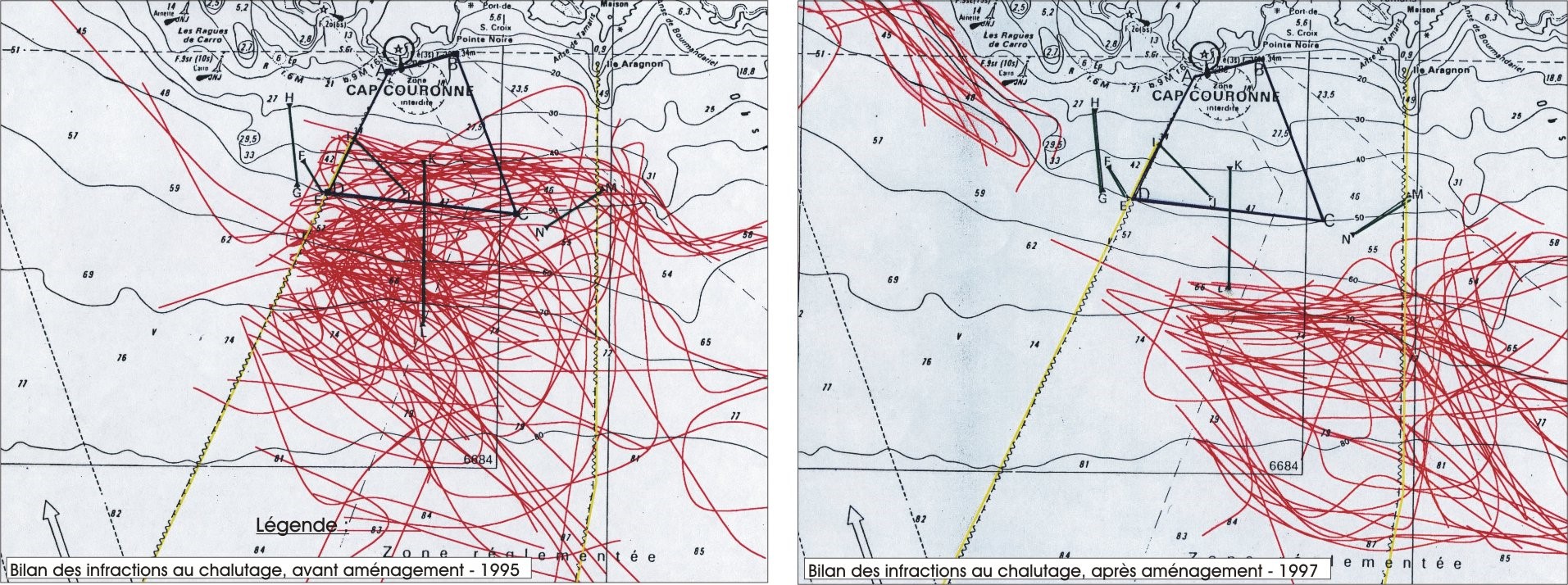Better knowledge for better management
Figure 2: main results of experimental fishing monitoring conducted by PMCB and artisanal fishers every 3 years in Couronne no-take reserve.
PMCB
UW visual census on fishes conducted every 3 years in the reserve of Couronne.
J.G. Harmelin/PMCB
The protection and surveillance within the 2 no-take reserves -where all kind of fishing, mooring and scuba diving are prohibited- is effective, with more than 2.400 hours of enforcement per year, mostly at sea, There is a great increase in fish biomass with an increase of abundance, more bigger fishes, and come back of rare/sensitive species like groupers, brown meagre, seabass, etc: Experimental controlled fishing operations are conducted every 3 years within the reserve and showed that in 24 years, the mean weight of a fish increased by a factor of 2.6 (287 g in 2019 vs. 111 g in 1995. During this time, fishing captures have been multiplied by a factor of 7, with a catch rate per CPUE effort unit increasing from 1.1 kg / 100 m of net in 1995 to a maximum of 7.1 kg / 100 m in 2019 (Figure 2).
These spectacular results and a clear reserve effect not only concern fishes, but also the invertebrates like spiny lobsters: catches were multiplicated per 8 since the creation of the reserve. These results are important for artisanal fishers who benefits to biomass exportation processes: in the borders of marine reserves, the fishing yields can reach 2.5 kg/100 m of net; while in the rest of MPA, the mean CPUE is 1kg/100 m.
Willingness and involvement of local artisanal fishers who decided themselves to create a second no-take reserve in PMCB in 1996 (Couronne, 210 ha), after the previous one in Carry (1983, 85 ha).The same fishing boat (“Mamyblue”) participate since the beginning to experimental fishing conducted every 3 years and fishers can see directly in the fish box the reserve effect when they bring back their nets, with a multiplication par 7 of catches (141 kg in 2019 vs 21 kg in 1995)
Long term monitoring showed a clear reserve effect with more fishes in abundance, more bigger and the return of rare species. Surveillance and enforcement is the keystone of a good management of no-take reserve. Nature can recreate biodiversity and restore by herself we need to help and take care of her, it’s our responsibility Even 6% of the Mediterranean Sea is covered by Marine Protected Areas, there is only 0.23% that is fully or highly protected. Less than a quarter of 1%, it’s really not enough! Marine Protected Areas are not only technical solutions, but also human relationships take into account, and history and culture of a territory, with a common vision.
No-take reserves worked well, even small superficies under full protection can restore biodiversity and resources. Necessity to realize scientific monitoring on a long period of time, for a better knowledge of reserve effect, with a BACI protocole (before/after/control/impact).
